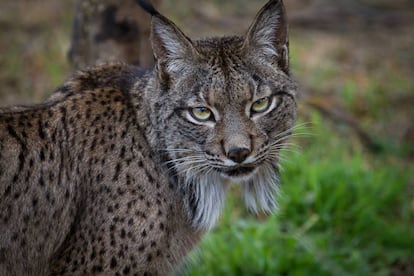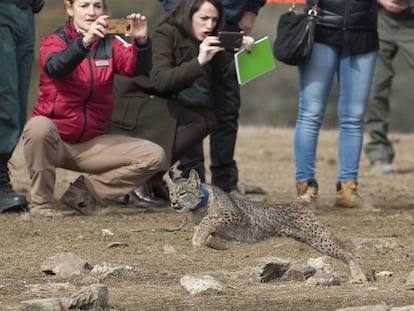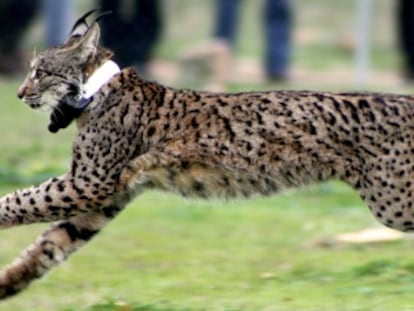Spain’s Iberian lynx population soars to 1,000, but species remains endangered
In 2020, 414 cubs were born, 30% more than the previous year, but experts warn that existing communities need to be urgently connected to prevent loss of genetic diversity
In 2002, the Iberian lynx (Lynx pardinus) was in a critical situation, with only 94 animals located in the southern Spanish region of Andalusia. But thanks to captive breeding programs and the creation of different nuclei, the population has increased more than tenfold in two decades. Last year, the species’ numbers in Spain and Portugal passed the 1,000-mark, with the population reaching 1,111, including both adults and cubs. According to the Ecological Transition Ministry, 414 cubs from 239 females were born in 2020 – an increase of 30% with respect to the previous year. The goal, says conservation group World Wildlife Fund (WWF), is to reach 750 breeding females in 2040.
But while there is cause for optimism, the wild cat continues to be classified as at risk of extinction in the Spanish Catalogue of Endangered Animals. Most Iberian lynxes (87%) are located in the southwest of the Iberian peninsula, particularly in the five nuclei in Andalusia, which is home to half of the species population in Spain. A third of this population is in Castilla-La Mancha, while 141 Iberian lynxes live in Extremadura. In Portugal, 140 of the wild cats are located in the Guadiana Valley Natural Park.
New populations of the Iberian lynx have also sprung up naturally – without having to be reintroduced – in the Sierra Norte mountain ranges and in Extremadura. This is good news because it means that when the animals disperse they can find others to mate with and do not have to continue searching until mating season. This success has been helped by the reintroduction of Iberian lynxes born in captivity. According to the minister of ecological transition, Teresa Ribera, 305 wild cats have been reintroduced since 2011, which has “surpassed initial expectations.”
“You can see that there are a growing number of cubs and what’s important is that they continue having enough territory in the areas where they are reintroduced and can continue expanding,” says Ramón Pérez de Ayala, the head of the lynx program at WWF. At the exponential rate the population is currently growing, the lynx nuclei could be overwhelmed if the species do not find new territory – a problem that also raises the risk of inbreeding. “As we have not begun to create new populations and connect existing ones, the current ones will be filled and the genetic diversity could be lost, which would jeopardize everything that has been achieved,” explains Pérez de Ayala.

This is the challenge facing the new European program Life Lynx Connect, which aims to create two new populations – one in Lorca, in Murcia, and another in Sierra Arana, in Granada – next year. In the meantime, the €18.7-million project is focusing on creating populations that could act as bridges between already existing populations. As these colonies are much smaller than the current nuclei, with four females instead of 15 to 20, the space needed for them also is much smaller.
Each female lynx uses between 500 and 1,000 hectares of space, depending on the number of rabbits, which are vital to the wild cat’s diet. The number of cubs in each litter also depends on food availability. The average breeding female lynx gives birth to 1.7 cubs, but this number varies depending on where they live: in Andújar and Doñana National Park, where there are few rabbits, females give birth between one and two cubs, while in the Montes de Toledo mountain range, the average is between three and four.
As the Iberian lynx population rises, so too has the number killed by cars, which are the greatest danger faced by the species when it is on the move. During the coronavirus spring lockdown, the number of road deaths increased even though there were fewer cars on the road. “As there was less traffic, the animals were less scared of the roads and cars were going faster,” explains Pérez de Ayala.
English version by Melissa Kitson.
Tu suscripción se está usando en otro dispositivo
¿Quieres añadir otro usuario a tu suscripción?
Si continúas leyendo en este dispositivo, no se podrá leer en el otro.
FlechaTu suscripción se está usando en otro dispositivo y solo puedes acceder a EL PAÍS desde un dispositivo a la vez.
Si quieres compartir tu cuenta, cambia tu suscripción a la modalidad Premium, así podrás añadir otro usuario. Cada uno accederá con su propia cuenta de email, lo que os permitirá personalizar vuestra experiencia en EL PAÍS.
¿Tienes una suscripción de empresa? Accede aquí para contratar más cuentas.
En el caso de no saber quién está usando tu cuenta, te recomendamos cambiar tu contraseña aquí.
Si decides continuar compartiendo tu cuenta, este mensaje se mostrará en tu dispositivo y en el de la otra persona que está usando tu cuenta de forma indefinida, afectando a tu experiencia de lectura. Puedes consultar aquí los términos y condiciones de la suscripción digital.
More information
Últimas noticias
Russian ultranationalism, inflamed by the killing of the hooligan commander ‘Spaniard’
The relentless struggle between factions deepens the Sinaloa war: bodies in coolers and a surge in homicides
‘Doctor Death’, the journalist who has witnessed 105 executions in Florida
Being trans or gay in a migrant detention center: ‘They call me faggot, queer, bitch’
Most viewed
- The low-cost creative revolution: How technology is making art accessible to everyone
- Christian Louboutin: ‘Young people don’t want to be like their parents. And if their parents wear sneakers, they’re going to look for something else’
- All the effects of gentrification in one corner of Mexico’s Colonia Roma
- Liset Menéndez de la Prida, neuroscientist: ‘It’s not normal to constantly seek pleasure; it’s important to be bored, to be calm’
- Christmas loses its festive spirit: ICE fears cast shadow over religious celebrations












































